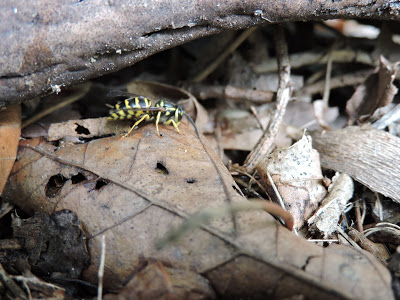Yellowjackets
Published on September 23, 2015
Yellowjackets (Vespula spp.) are social wasps who can be beneficial most of the year. They, however, often come in conflict with people, especially in the Fall. Because of their striped appearance, they are often confused with bees, and most stings are actually due to Yellowjackets rather than bees. They are more slender, with the thin wasp waist, and normally not very hairy as compared to bees such as honeybees.

A Yellowjacket worker searches the forest floor for a meal for her and her nest mates.
Yellowjackets as adults feed on sugars, nectar, rotting fruit, and occasionally scavenge. They can be minor pollinators of some flowers, but just are not built for it since they do not need to collect pollen to feed their young. Instead, they feed their young proteins in the form of insects and spiders that they sting and bring back to their nests. In this manner, they can be beneficial in controlling some insect populations, though they will just as likely sting and kill a beneficial insect as they would any pest species. If their prey is too large, the wasps will bring it back in pieces or ingest it to regurgitate back to the nest’s young later. For a video showing one trying to capture a large food item, check out this short clip from the Capital Naturalist YouTube Channel.
Yellowjackets are social insects, with a queen laying eggs and workers (her daughters) providing such labor as building and repairing the nest, foraging for food, and defense. Males (drones) are produced once a year in the Fall. After mating, the newly fertilized queens find a secluded spots underground or in old logs to overwinter. The males die soon after mating. The old queen and her workers all die also, at least in our part of the country.
In the spring, the new queen awakens and goes out to search for a place to start her nest. She often picks an old rodent burrow or rotten log. While most nests are underground, they will occasionally find open spaces in walls or build an aerial nest (there’s one species, Aerial Yellowjackets, that almost always do). The nest is constructed of wood fibers that are chewed into pulp and then made into paper building material. This she uses to make the nest and the cells she lays her eggs into.
Read more at the Capital Naturalist blog.